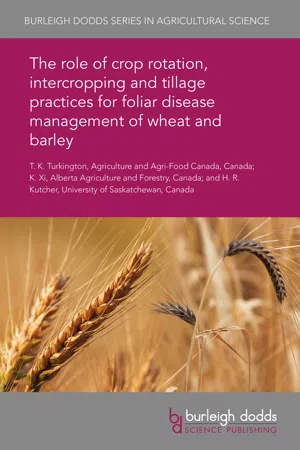
The role of crop rotation, intercropping and tillage practices for foliar disease management of wheat and barley
- English
- PDF
- Available on iOS & Android
The role of crop rotation, intercropping and tillage practices for foliar disease management of wheat and barley
About this book
The great majority of modern agro-ecosystems comprise rotations of a small number of crop species where each year's crop is a genetically uniform monoculture. The narrow genetic basis for disease resistance in modern cultivars increases the potential for pathogens to overcome this resistance and attack a large number of plants at a similar state of development. In this chapter, we present a number of strategies for limiting foliar disease development in wheat and barley. We discuss how crop rotations with non-cereal species can substantially reduce inoculum sources for residue-borne cereal leaf diseases. Further strategies, such as intercropping, gene deployment and conversation tillage, are then presented, with discussion of the effectiveness of each strategy against particular foliar diseases. It is concluded that there is potential for residue-borne cereal leaf diseases to be managed under conservation tillage via crop rotation, fungicide application and careful choice of variety.
Frequently asked questions
- Essential is ideal for learners and professionals who enjoy exploring a wide range of subjects. Access the Essential Library with 800,000+ trusted titles and best-sellers across business, personal growth, and the humanities. Includes unlimited reading time and Standard Read Aloud voice.
- Complete: Perfect for advanced learners and researchers needing full, unrestricted access. Unlock 1.4M+ books across hundreds of subjects, including academic and specialized titles. The Complete Plan also includes advanced features like Premium Read Aloud and Research Assistant.
Please note we cannot support devices running on iOS 13 and Android 7 or earlier. Learn more about using the app.
Information
Table of contents
- 1 Introduction
- 2 Increasing temporal diversity: crop rotation
- 3 Increasing spatial diversity: intercropping
- 4 Increasing genetic diversity: gene deployment
- 5 The role of conservation tillage
- 6 Conclusions and future trends
- 7 Where to look for further information
- 8 References